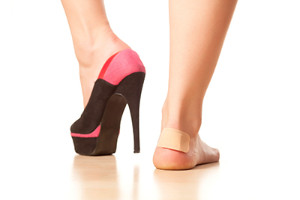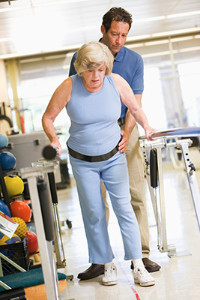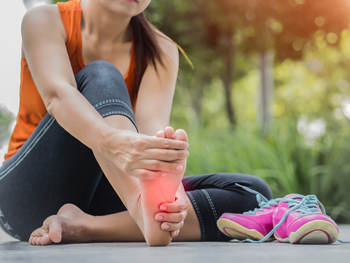Miami Shores (305) 631-2698

The bones in babies feet are flexible as a result of being underdeveloped. This is how most babies are born, and they appear to be flat footed. As walking begins, the bones, muscles, and tendons will gradually become stronger, and the arch will typically develop. While toddlers are indoors, it is beneficial for them to walk barefoot. This is helpful in strengthening the foot as the toes grasp the floor. When it is time for shoes to be purchased, it is important that your child’s feet are measured correctly, as this generally ensures shoes that fit properly are worn. The shoes need to have adequate room for the toes to move freely in, and the soles should be constructed of a flat and flexible sole. If you would like additional information about how to buy children’s shoes, it is suggested to consult with a podiatrist.
The health of a child’s feet is vital to their overall well-being. If you have any questions regarding foot health, contact Dr. Adam Auster of Florida. Our doctor can provide the care you need to keep you pain-free and on your feet.
Tips for Keeping Children's Feet Healthy
If you have any questions, please feel free to contact our offices located in Miami Shores and South Miami, FL. We offer the newest diagnostic and treatment technologies for all your foot care needs.
Read more about How to Care for Your Child's Feet Wearing high heels is often a part of a fashion statement. Many women enjoy wearing this type of shoe for the way the legs look when the heel is elevated, but it may come with a price to pay. Research has indicated that wearing high heels may cause tripping to occur, and the result could be an ankle sprain. This may be due to shortened calf muscles, and the ankles may become weak as they are attempting to balance in the shoes. A common foot condition that can possibly occur if high heels are frequently worn can be the formation of a bunion. This consists of a bony protrusion that develops on the side of the big toe that may come from the toes having inadequate room to move freely in. If the desire to wear this type of shoe is strong, it may be beneficial to wear a heel that is slightly lower and can offer proper support. If you would like additional information about how high heels can affect your feet, please consult with a podiatrist.
Wearing high heels is often a part of a fashion statement. Many women enjoy wearing this type of shoe for the way the legs look when the heel is elevated, but it may come with a price to pay. Research has indicated that wearing high heels may cause tripping to occur, and the result could be an ankle sprain. This may be due to shortened calf muscles, and the ankles may become weak as they are attempting to balance in the shoes. A common foot condition that can possibly occur if high heels are frequently worn can be the formation of a bunion. This consists of a bony protrusion that develops on the side of the big toe that may come from the toes having inadequate room to move freely in. If the desire to wear this type of shoe is strong, it may be beneficial to wear a heel that is slightly lower and can offer proper support. If you would like additional information about how high heels can affect your feet, please consult with a podiatrist.
High heels have a history of causing foot and ankle problems. If you have any concerns about your feet or ankles, contact Dr. Adam Auster from Florida. Our doctor can provide the care you need to keep you pain-free and on your feet.
Effects of High Heels on the Feet
High heels are popular shoes among women because of their many styles and societal appeal. Despite this, high heels can still cause many health problems if worn too frequently.
Which Parts of My Body Will Be Affected by High Heels?
What Kinds of Foot Problems Can Develop from Wearing High Heels?
How Can I Still Wear High Heels and Maintain Foot Health?
If you want to wear high heeled shoes, make sure that you are not wearing them every day, as this will help prevent long term physical problems. Try wearing thicker heels as opposed to stilettos to distribute weight more evenly across the feet. Always make sure you are wearing the proper shoes for the right occasion, such as sneakers for exercising. If you walk to work, try carrying your heels with you and changing into them once you arrive at work. Adding inserts to your heels can help cushion your feet and absorb shock. Full foot inserts or metatarsal pads are available.
If you have any questions please feel free to contact our offices located in Miami Shores and South Miami, FL. We offer the newest diagnostic and treatment technologies for all your foot and ankle needs.
Read more about Effect of High Heels on the FeetFalls prevention is an important topic for older people. Being they will undergo physical changes and health conditions, this puts them more at risk to falls. There are six simple steps that will help prevent falls. The first step is to make an appointment with your doctor. It is important to be able to answer questions such as “What medications are you taking?”, “Have you fallen before?”, and “Can your health conditions potentially cause a fall?”. Having solutions to these questions will allow you to be more cautious. The second step is to keep moving. Staying active by taking part in physical activities will reduce the risk of falls by improving strength, balance, coordination and flexibility. The third step is to wear sensible shoes. Sturdy, properly fitting shoes will not be a safety hazard and can also help reduce joint pain. The fourth step is to remove any hazards in your house. It is important to clear the home of anything blocking the walking path such as wires, and to place non-slip mats on the floor so that you are not at risk of slipping on wet surfaces. The fifth step is to light up the living space. Whenever you are home, keep the lights on in each room you enter, in order to avoid tripping on objects that may be hard to see in the dark. The sixth and final step is to use assistive devices in your home. Use the hand rails when walking up and down the stairs, grab bars for the shower and a raised toilet seat when going to the bathroom. If you feel you may be prone to falls, see a podiatrist to discuss the best preventative options.
for older people. Being they will undergo physical changes and health conditions, this puts them more at risk to falls. There are six simple steps that will help prevent falls. The first step is to make an appointment with your doctor. It is important to be able to answer questions such as “What medications are you taking?”, “Have you fallen before?”, and “Can your health conditions potentially cause a fall?”. Having solutions to these questions will allow you to be more cautious. The second step is to keep moving. Staying active by taking part in physical activities will reduce the risk of falls by improving strength, balance, coordination and flexibility. The third step is to wear sensible shoes. Sturdy, properly fitting shoes will not be a safety hazard and can also help reduce joint pain. The fourth step is to remove any hazards in your house. It is important to clear the home of anything blocking the walking path such as wires, and to place non-slip mats on the floor so that you are not at risk of slipping on wet surfaces. The fifth step is to light up the living space. Whenever you are home, keep the lights on in each room you enter, in order to avoid tripping on objects that may be hard to see in the dark. The sixth and final step is to use assistive devices in your home. Use the hand rails when walking up and down the stairs, grab bars for the shower and a raised toilet seat when going to the bathroom. If you feel you may be prone to falls, see a podiatrist to discuss the best preventative options.
Preventing falls among the elderly is very important. If you are older and have fallen or fear that you are prone to falling, consult with Dr. Adam Auster from Florida. Our doctor will assess your condition and provide you with quality advice and care.
Every 11 seconds, an elderly American is being treated in an emergency room for a fall related injury. Falls are the leading cause of head and hip injuries for those 65 and older. Due to decreases in strength, balance, senses, and lack of awareness, elderly persons are very susceptible to falling. Thankfully, there are a number of things older persons can do to prevent falls.
How to Prevent Falls
Some effective methods that older persons can do to prevent falls include:
Falling can be a traumatic and embarrassing experience for elderly persons; this can make them less willing to leave the house, and less willing to talk to someone about their fears of falling. Doing such things, however, will increase the likelihood of tripping or losing one’s balance. Knowing the causes of falling and how to prevent them is the best way to mitigate the risk of serious injury.
If you have any questions, please feel free to contact our offices located in Miami Shores and South Miami, FL. We offer the newest diagnostic and treatment technologies for all your foot care needs.
Read more about Falls Prevention A hammertoe is described as the abnormal bending at the middle joint of the toe. Over time, the toe becomes more rigid, and corns and bunions may begin to develop. Possible causes of hammertoe include genetic factors, injuries, and ill-fitting shoes. In order to make the discomfort from a hammertoe more manageable, you should wear wider shoes, and make sure the type of shoe is appropriate for the activity you are engaging in. Anti-inflammatory medications are also an option. If the pain becomes too severe, surgery is a possibility. In this surgery, the corn and a portion of the problematic knuckle would be removed. However, a hammertoe can come back after the surgery. In order to avoid this condition from occurring again, do not wear shoes that are pointy or too narrow in the toe area. If you believe you may have a hammertoe, it is suggested that you consult with a podiatrist who can help.
A hammertoe is described as the abnormal bending at the middle joint of the toe. Over time, the toe becomes more rigid, and corns and bunions may begin to develop. Possible causes of hammertoe include genetic factors, injuries, and ill-fitting shoes. In order to make the discomfort from a hammertoe more manageable, you should wear wider shoes, and make sure the type of shoe is appropriate for the activity you are engaging in. Anti-inflammatory medications are also an option. If the pain becomes too severe, surgery is a possibility. In this surgery, the corn and a portion of the problematic knuckle would be removed. However, a hammertoe can come back after the surgery. In order to avoid this condition from occurring again, do not wear shoes that are pointy or too narrow in the toe area. If you believe you may have a hammertoe, it is suggested that you consult with a podiatrist who can help.
Hammertoes can be a painful condition to live with. For more information, contact Dr. Adam Auster of Florida. Our doctor will answer any of your foot- and ankle-related questions.
Hammertoe
Hammertoe is a foot deformity that occurs due to an imbalance in the muscles, tendons, or ligaments that normally hold the toe straight. It can be caused by the type of shoes you wear, your foot structure, trauma, and certain disease processes.
Symptoms
Risk Factors
Treatment
If you have hammertoe, you should change into a more comfortable shoe that provides enough room for your toes. Exercises such as picking up marbles may strengthen and stretch your toe muscles. Nevertheless, it is important to seek assistance from a podiatrist in order to determine the severity of your hammertoe and see which treatment option will work best for you.
If you have any questions, please feel free to contact our offices located in Miami Shores and South Miami, FL. We offer the newest diagnostic and treatment technologies for all your foot care needs.
Read more about Hammertoe The location of the sesamoid bones is inside a tendon in the foot. The two bones are next to each other under the big toe joint in the bottom of the foot. They help to raise and move the big toe and can push off the ground while running. They take the strain off the foot while walking and running by absorbing the weight of the foot. If these bones should become inflamed, a condition that is referred to as sesamoiditis develops. It happens as a result of pressure that is exerted on the sesamoid bones and is a common condition among runners. There may be existing circumstances that lead to this ailment, including having high arches, or feet that have minimal cushioning on the sole of the foot. The symptoms that are common with sesamoiditis will typically include achiness in the ball of the foot, and a severe, throbbing sensation. If you feel you have sesamoiditis, it is advised to consult with a podiatrist, so proper treatment can begin.
The location of the sesamoid bones is inside a tendon in the foot. The two bones are next to each other under the big toe joint in the bottom of the foot. They help to raise and move the big toe and can push off the ground while running. They take the strain off the foot while walking and running by absorbing the weight of the foot. If these bones should become inflamed, a condition that is referred to as sesamoiditis develops. It happens as a result of pressure that is exerted on the sesamoid bones and is a common condition among runners. There may be existing circumstances that lead to this ailment, including having high arches, or feet that have minimal cushioning on the sole of the foot. The symptoms that are common with sesamoiditis will typically include achiness in the ball of the foot, and a severe, throbbing sensation. If you feel you have sesamoiditis, it is advised to consult with a podiatrist, so proper treatment can begin.
Sesamoiditis is an unpleasant foot condition characterized by pain in the balls of the feet. If think you’re struggling with sesamoiditis, contact Dr. Adam Auster of Florida. Our doctor will treat your condition thoroughly and effectively.
Sesamoiditis
Sesamoiditis is a condition of the foot that affects the ball of the foot. It is more common in younger people than it is in older people. It can also occur with people who have begun a new exercise program, since their bodies are adjusting to the new physical regimen. Pain may also be caused by the inflammation of tendons surrounding the bones. It is important to seek treatment in its early stages because if you ignore the pain, this condition can lead to more serious problems such as severe irritation and bone fractures.
Causes of Sesamoiditis
Treatment for sesamoiditis is non-invasive and simple. Doctors may recommend a strict rest period where the patient forgoes most physical activity. This will help give the patient time to heal their feet through limited activity. For serious cases, it is best to speak with your doctor to determine a treatment option that will help your specific needs.
If you have any questions please feel free to contact our offices located in Miami Shores and South Miami, FL. We offer the newest diagnostic and treatment technologies for all your foot and ankle needs.
Read more about Sesamoiditis